September 2022
Selling Imperialist War, from 1898
to ... WWIII?
“You Furnish the Pictures,
and I’ll Furnish the War”
If you want to push a war drive abroad, flood the public with war propaganda on the home front. Feature blood-curdling images, sound bites, and plenty of propaganda for good vs. evil, us vs. them. Like they say, “Keep it simple, stupid.” Lay it on as thick as possible. Don’t let up – it’s got to be relentless. No questions asked or allowed. Any doubt about the story? That’s downright unpatriotic – there ought to be a law against it. Maybe there will be soon. And since “our” government is the embodiment of democracy, it must be telling the truth.
So say U.S. imperialism’s media masters of war.
It’s all on daily display right now in these United States. Casting Russia and China as the evil empires to be vanquished, hailing U.S. imperialism’s latest good guys du jour, the big business media egg on Washington’s escalating war provocations, from the straits of Taiwan to the Ukraine/Russia front. But the pattern was set long ago.
Way back in 1897, mass-media mogul William Randolph Hearst worked out the playbook. “You Furnish the Pictures, and I’ll Furnish the War.” This, the history books tell us, is what Hearst cabled to his star illustrator in the lead-up to the Spanish-American War. Shocking and heart-wrenching images were urgently needed, the pioneer of “yellow” (sensationalist) journalism insisted. What for? Why, to sell lots of newspapers from the Hearst media empire, of course. But above all, to sell the war – which, soon enough, broke out and made the United States a player in the big league of imperialist powers.
“Remember the Maine!”
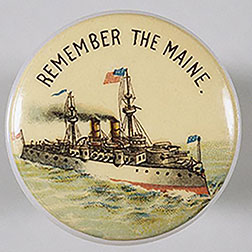 Button with image from “Remember the Maine”
poster promoting 1898 U.S. imperialist war with Spain that
led to seizure of Puerto Rico, Philippines, Guam and
occupation of Cuba.
Button with image from “Remember the Maine”
poster promoting 1898 U.S. imperialist war with Spain that
led to seizure of Puerto Rico, Philippines, Guam and
occupation of Cuba.So Hearst, his fellow colonialist Teddy Roosevelt, plus a
raft of fellow empire-builders, robber barons, racists and
war enthusiasts were more than ready in February 1898, when
the U.S. battleship Maine blew up in Havana harbor.
Long before the bullets were flying and actual bombs
started falling, the U.S. public was being relentlessly
bombarded with war propaganda. This included plenty of
bloodcurdling pictures, including of the Maine in
flames.
“Remember the Maine, To Hell with Spain!” The slogan harked back to “Remember the Alamo,” the motto for the 1846-48 war in which U.S. forces under Democratic president James Polk seized almost half of Mexico. In 1898, “Remember the Maine” became the motto for the “splendid little war” (as Teddy Roosevelt’s sidekick John Hay called it) in which the U.S. occupied Cuba and seized Puerto Rico, the Philippines and Guam outright as colonies from the decrepit Spanish empire.
The Hearst press was in the front lines of the media war that sold the public back home – traditionally trained to contrast the U.S. with the old empires of Europe –– on this bloody crusade of colonial conquest. It showered the U.S. public with images and stories, especially of crazed and bloodthirsty Spaniards wantonly targeting Cuban women and children. Clearly, it proclaimed, Uncle Sam had to save them from the forces of evil incarnate. If official “news” hit a dry spell, Hearst made his own, like the saga of “the most beautiful girl on the island of Cuba,” Evangelina Cisneros, whom a reporter for Hearst’s New York Journal allegedly rescued, with swashbuckling feats of heroism, from Spanish imprisonment.
In the Philippines, meanwhile, the U.S. military annihilated hundreds of thousands in a scorched-earth counterinsurgency campaign that set the pattern for the genocidal onslaughts it carried out against Korea and Vietnam decades later. This included the massive use of torture (particularly the “water cure,” as waterboarding was called at that time), concentration camps, and the infamous order to turn Samar province into “a howling wilderness” and “kill everyone over the age of ten.”
In his notorious hymn to U.S. imperialism, “The White Man’s Burden” (1899), British colonialist Rudyard Kipling, outspoken in his racism, saluted Uncle Sam’s new conquests. In the U.S., the capitalist media went all-out in marketing the dollar empire’s onslaught as a noble crusade for freedom and so-called civilization. As part of this campaign, endless cartoons showed “the enemy” as a ravenous beast. Just two years before the war, the Supreme Court had issued its “separate but equal” Plessy v. Ferguson decision (1896). Racist caricatures of African Americans that were used on a massive scale to sell Jim Crow ideology were now recycled by the capitalist press, to dehumanize and ridicule U.S. imperialism’s new colonial subjects overseas, whom Kipling brazenly called “your new-caught, sullen peoples.”
The Hearst press had played first fiddle in the enterprise of preparing, hyping and justifying the Spanish-American War. Yet its efforts were dwarfed by what would soon occur. The First World War was around the corner. As Bolshevik leader V.I. Lenin explained in his essential Imperialism: The Highest Stage of Capitalism (1916), the development of monopoly capital had led to the ruthless carving up of the world among the dominant, richest capitalist countries. Now the decline of some of the old powers, and the rise of new ones – among them Germany, Japan and the U.S. – led to a new war, on a previously unimagined scale, for the redivision of the world.
This first imperialist World War broke out in the summer of 1914. While reformist social democrats supported “their own” capitalist governments and helped them recruit cannon fodder for the slaughter, German revolutionary Karl Liebknecht raised the slogan “The Main Enemy Is at Home!” Calling to “turn the imperialist war into a civil war,” Lenin pointed the way for ending capitalist wars once and for all when, together with Leon Trotsky, he led the Russian Revolution in 1917.
To “Shape and Train a Nation for War”
In the U.S., Democrat Woodrow Wilson was elected U.S. president in 1912. Rivaling Teddy Roosevelt in his virulent racism, Wilson screened the KKK propaganda film Birth of a Nation in the White House. When the war began, his administration backed Britain, France and Russia (then under the rule of the Tsar) against their imperialist rivals in the “Central Powers” headed up by Germany. Billions in U.S. loans helped finance the war effort of the British and French colonial empires. Yet the U.S. public had little appetite for entanglement in the European conflict. In 1916 Wilson ran again, on the slogan “He Kept Us Out of War,” and won reelection.
The problem Wilson now faced: how to prepare the population for the U.S. entering the war. The British ocean liner Lusitania, carrying over 170 tons of munitions together with civilian passengers, including some Americans, had been sunk the previous year by Germany (which had warned it would attack the ship). Thus “Remember the Lusitania!” would eventually factor into the U.S. casus belli (pretext for war), together with the January 1917 “Zimmermann telegram” in which Germany invited Mexico to join its side in the conflict in order to regain territory the U.S. had seized in the Mexican-American War.
In March 1917, less than a month after being inaugurated for his second term as president, Wilson addressed Congress with a call for the U.S. to declare war on Germany. Needless to say, he did not declare that the goal was for U.S. imperialism, having defeated Spain two decades previously, to now become the dominant capitalist power on a world scale. Instead, he said the war, which had already piled up tens of millions of corpses, was “to make the world itself at last free” and – one of history’s best-known war-marketing slogans – “safe for democracy.”
Snapping to attention, Congress declared war and voted billions to build up the armed forces. In a proclamation on draft registration, Wilson stated: “It is not an army that we must shape and train for war – it is a nation.” Since conscripting soldiers for the army was the purpose of his May 1917 proclamation (followed the next day by Congress passing the Selective Service Act), the phrase might seem a bit odd.
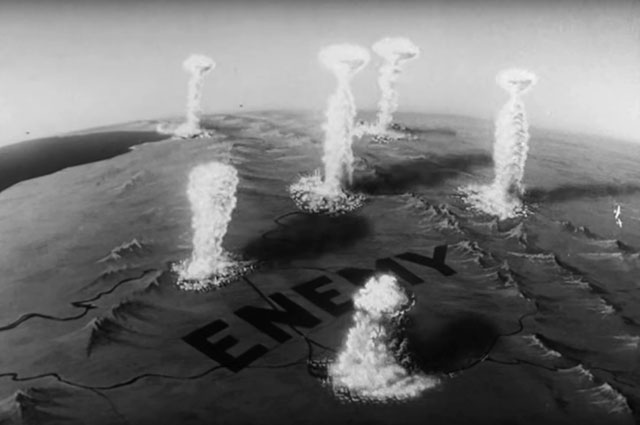
Still from Korean War-era U.S. Air Force film that threatened nuclear destruction of “enemy” cities, stating U.S. should “not hesitate” to use this “destructive power” if “necessary.” (From 1982 documentary The Atomic Cafe.) (Photo: The Atomic Café)
Yet the U.S. imperialist chief was dead serious when he called to shape and train the nation for war. This was precisely Wilson’s purpose when weeks earlier he issued an executive order establishing the Committee on Public Information (CPI), which, despite its innocuous name, would become in effect his ministry of war propaganda. “Forging a white-hot war-will” was how CPI head George Creel described its mission. A journalist and Democratic Party activist, Creel was appointed after three cabinet members – the secretaries of State, War and the Navy – urged the president to recruit a civilian who could “gain the understanding of the press.” They further recommended that in the CPI, “the two functions – censorship and publicity – be joined in honesty and profit.” (Three guesses as to which of the latter would prevail.)
Working together with its Division of “News,” the CPI’s special Bureau of War Photographs and Division of Pictures (created by another of Wilson’s executive orders) followed Hearst’s admonition to “Furnish the Pictures” in order to help furnish the war. The CPI’s functions and operations were amazingly far-reaching. As one study on the subject notes:
“For its domestic program (there was also a foreign section that eventually had offices in over 30 countries), the CPI took advantage of every existing communications link between Washington’s wartime policies and every identifiable segment of the American people – and forged new ones. The CPI prepared press releases and news stories by the bushelful and enlisted scholars to write propaganda pamphlets.... It then printed and distributed them by the tens of millions.”
The same study observes that in addition to organizing a network of tens of thousands of speechmakers (knows as the Four-Minute Men),
“The CPI ... placed advertisements in hundreds of newspapers and magazines; designed, printed, and distributed untold numbers of posters, which were pasted up all over the country; produced its own film documentaries and rigidly controlled the content of Hollywood-made motion pictures; published a daily newspaper; ran war expositions and scheduled lecturers; prepared collateral publicity and advertising material such as photographs, slides, cartoons, and postcards. Behind the scenes, CPI ghost writers quietly wrote newspaper stories, magazine articles, and books.”1
All this is eerily familiar in 2022, though today’s unending war-drive propaganda frenzy incorporates countless newer media outlets and technologies. Like William Randolph Hearst’s infamous New York Journal back in the day, the modernized media chorus serves the imperialist masters of war.[2] Right-wing rags like the Murdoch empire’s low-rent Post pitch in with old war horses like the liberal New York Times, whose motto might as well be: “All the U.S. War Propaganda That Fits, We Print.” And now it seems there’s virtually no escape, almost any time you look at a screen of any kind, listen to so-called news, get inundated with memes, reels or the latest idiotic barrage of ads, and so forth – ad nauseam.
“Poor Little Belgium”
The CPI brought patriotic imagery and flag-waving sloganeering into the service of signing up soldiers and selling “Liberty” war bonds. It was joined in the war-promotion biz by many private companies and public organizations. Both aggressive jingoism and somber sentimental appeals were employed. The most famous of all was the poster of Uncle Sam pointing at the viewer with the message “I Want You for U.S. Army,” while one for kids proclaimed: “Boys and Girls! You can help your Uncle Sam Win the War. Save Your Quarters – Buy War Savings Stamps.”
As in the Spanish-American War, images and slogans about saving women and children were often featured. When Germany headed to attack the French army as WWI began, its troops invaded Belgium, which though a colonial power in its own right, was a much smaller country. “‘Poor little Belgium,’ martyred by the German invader,” the International Encyclopedia of the First World War notes, “became an effective symbol for international belligerents to sharpen their propaganda weapons.” (“Gallant Belgium” and “brave little Belgium” were popular variants.)
Alert to the opportunities, the British government’s War Propaganda Bureau (yes, that was its real name) pumped out a steady stream of atrocity stories – for example, that German troops were in the habit of bayoneting Belgian babies – which the U.S. media eagerly took up. A major objective was to promote the idea that Britain, the U.S. and their allies were waging the war to “defend poor little Belgium.” A range of different CPI posters urged “Remember Belgium,” with over a million copies printed of the most famous one, featuring a prominent artist’s silhouetted representation of the German Kaiser abducting a young woman.3 A decade before WWI, an international outcry had broken out against the colonialist genocide Belgium carried in the Congo, which had been turned into a vast rubber plantation by Belgium’s King Léopold II.4 So it took some work for the CPI to sell the image of Belgium as one of the “good guys” in the official U.S. war story for WWI.
Posters luridly depicting the need to protect women and children here “at home” from an imaginary German invasion of the U.S. were produced in many variants. These were often paired with pictures and slogans against “the Hun,” a slur adopted by the British and U.S. governments as a national-chauvinist term interchangeably used for Germany, the German Kaiser, or German people. “Hun or Home?” asked one poster. “Beat Back the Hun with Liberty Bonds,” urged another from the Division of Pictorial Publicity. Yet another showed a young man getting ready to sign up for the Marine Corps, having just read a headline stating “Huns Kill Women and Children!”
Best known today is the lurid poster depicting Germany’s Kaiser Wilhelm (grandson of Britain’s Queen Victoria) as a ravenous ape in the act of carrying away a half-nude blond woman. The poster declaimed: “Destroy this Mad Brute – Enlist.” Today, an anti-China version of the same grotesque image and slogan – available as a sticker, t-shirt (including kid’s size), mug, magnet or mask – is being hawked online, whipping up deadly “yellow peril” racism and anti-communism in line with the escalating U.S. war drive.
The year before Wilson took the U.S. into WWI, over 100,000 people marched in a “Preparedness Parade” in New York City featuring a banner demanding “Absolute and Unqualified Loyalty to Our Country.” Former president Teddy Roosevelt spearheaded a campaign for “100 percent Americanism.” Accusations of “un-American” beliefs or behavior – prefiguring the Cold War McCarthyite crusade – helped fuel mob attacks and state repression. Prominent targets included the Industrial Workers of the World (IWW, also known as the Wobblies), whose courageous “free speech fights” challenging censorship and police tyranny had begun well before the war. In 1915 the great IWW song writer Joe Hill was executed on a frame-up murder charge by the state of Utah. In 1916, the sheriff of Everett, Washington led hired vigilantes in a massacre against Wobbly activists during a militant shingle workers strike.
Imperialist War Abroad, Repression on the Home Front
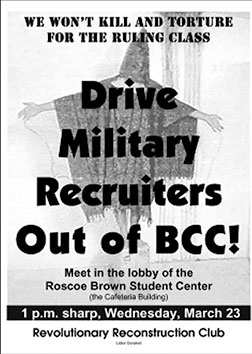 Flier for Revolutionary
Reconstruction Club (RRC) protest against military
recruiters at Bronx Community College, March 2005. In 2004,
images of U.S. soldiers torturing prisoners at Abu Ghraib
prison in Iraq were made public, prompting widespread
outrage and demonstrations against the war. RRC joined in
forming CUNY Internationalist Clubs and in launching
Revolution in 2003.
Flier for Revolutionary
Reconstruction Club (RRC) protest against military
recruiters at Bronx Community College, March 2005. In 2004,
images of U.S. soldiers torturing prisoners at Abu Ghraib
prison in Iraq were made public, prompting widespread
outrage and demonstrations against the war. RRC joined in
forming CUNY Internationalist Clubs and in launching
Revolution in 2003.Not long after the U.S. declared war in 1917, federal agents raided almost 50 IWW halls across the country. Frank Little, a famous Wobbly organizer who called himself “1/2 white, 1/2 Indian, all IWW,” was lynched in Butte, Montana after giving speeches against the war. A June 1918 speech against the war, censorship and repression that veteran Socialist leader Eugene V. Debs gave in Canton, Ohio led to his arrest and conviction under the Espionage Act, which Wilson had signed into law after the U.S. joined WWI. In 1918 the Espionage Act was expanded by the Sedition Act, which made it illegal to “willfully utter, print, write, or publish any disloyal, profane, scurrilous, or abusive language about the form of the Government of the United States” or to “willfully urge, incite, or advocate any curtailment of the production” of the things “necessary or essential to the prosecution of the war.”
At least 1,000 people were convicted under the Espionage and Sedition acts. In a series of cases, the Supreme Court specifically upheld the convictions of Debs and other leftists. These included the case of Jacob Abrams in New York City, who was part of a group of immigrant left activists sentenced to long prison terms for distributing leaflets that called on workers to strike in opposition to U.S. military intervention against the Bolsheviks in the Russian Civil War. While the Sedition Act was eventually repealed, many parts of the original Espionage Act remain in force, and it was used in 1973 to charge Daniel Ellsberg, who leaked the Pentagon Papers (giving the inside story of the U.S. war against Vietnam); charges against him were finally dismissed. More recently, the Act has been used against Edward Snowden, who leaked documents about the large-scale National Security Agency surveillance program in 2013. In 2019, federal charges against Wikileaks founder Julian Assange – for exposing U.S. war crimes and intelligence agency “dirty tricks” – included 17 counts of violation of the Espionage Act.5
Oddly, back in 1917, in a case known as The United States v. Motion Picture Film “The Spirit of ’76,” the Espionage Act was used against a silent movie of that title, whose producer Richard Goldstein declared that he was just trying to make a flag-waving, “Yankee Doodle Dandy” tear-jerker about the American Revolution. The judge denounced the film for depicting the July 1778 massacre of hundreds of colonists in Pennsylvania by the British army, as well as scenes involving the bayoneting of a Yankee baby and “other unspeakable atrocities committed by British soldiers, including the shooting of harmless women, the dragging off, sometimes by the hair of the head, of young American girls, etc.” He explained that while in the 1770s “we were at war with Great Britain during the Revolutionary times,” in 1917 “we are engaged in a war in which Great Britain is an ally of the United States.” A film like this could have the “effect of sowing dissension among our people, and of creating animosity or want of confidence between us and our allies,” His Honor proclaimed.6 Goldstein got a 10-year sentence.
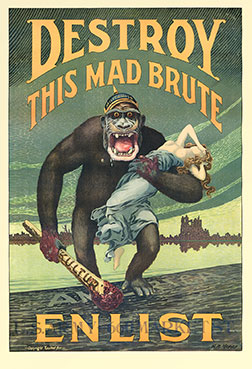 U.S. Army recruitment
poster (circa 1917) uses anti-German propaganda themes to
sell U.S. joining World War I, depicting “the enemy”
(Germany) as rabid beast invading shores of America,
carrying off damsel in distress.(Photo:
Harry R. Hopps)
U.S. Army recruitment
poster (circa 1917) uses anti-German propaganda themes to
sell U.S. joining World War I, depicting “the enemy”
(Germany) as rabid beast invading shores of America,
carrying off damsel in distress.(Photo:
Harry R. Hopps)Jingoist culture purges, repression and the relentless din of war propaganda emerge time and again as links in the unending chain of wars that the U.S. has carried out or promoted from before the Spanish-American War to WWI (which Woodrow Wilson pitched as “the war to end all wars”) and down to the present day. Building on methods employed by William Randolph Hearst in the build-up for the 1898 war, George Creel’s CPI developed and honed techniques during the imperialist First World War. As one of the many in-depth books on the subject notes: “In World War II, during the cold war, and through the Vietnam era, the propaganda machine set into motion by George Creel in 1917-1918 continued to grind.”7
Fast forward to the 21st century. Millions of Gen Z youth heading back to school this fall were born amidst a conflict – the Iraq War (2003-11) – in which U.S. imperialism’s war propaganda merchants played a huge role in paving the way for death and destruction on a massive scale. Yet if we surveyed U.S. college-age youth right now, it’s safe to say the story of what happened back then would be murky to most.
This June, in brief remarks at a public forum on “democracy,” a former U.S. president unexpectedly referred to “the decision of one man to launch a totally unjustified and brutal invasion of Iraq.” It was a strange venue for this denunciation, since he was speaking at the George W. Bush Presidential Center in Dallas, Texas (which houses, among other things, the Freedom Hall, the Defending Freedom Table, and the George W. Bush Presidential Library and Museum). Odder still was that the man giving the speech was George W. Bush himself. In 2003, he was the man who launched the brutal and criminal U.S. invasion of Iraq. Seemingly embarrassed, Bush tried to recoup: “I mean – of Ukraine,” he blurted. “Iraq, too. Anyway.” Media pundits filled the airwaves with analyses of the White House ex-denizen’s “Freudian slip.”
George W. Bush is hailed today as a hero of “democracy” by Democratic politicians. Former first lady Michelle Obama gets photographed hugging him, proclaiming Bush to be her “beautiful” friend and “partner in crime.” In fact, like a string of Democratic and Republican presidents before and after him, Bush Jr. is a literal war criminal. Leaked photos of unspeakable sadism at the U.S. military’s Abu Ghraib torture site showed the meaning of his “Operation Iraqi Freedom.” The murderous “Operation Enduring Freedom” he launched in 2001 with the occupation of Afghanistan – part of U.S. imperialism’s terrorist “War on Terror” – took over a quarter million lives as it continued for two decades under Barack Obama and Donald Trump, up until August 2021 when Biden called it quits as the failed imperialist terror war ended in chaos.8
Incubators, WMDs and “Freedom Fries”
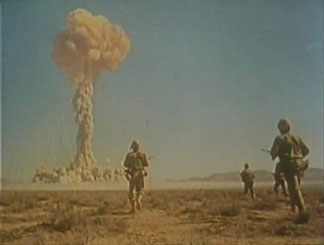 Soldiers ordered to run toward
mushroom cloud from nuclear bomb in U.S. military’s 1957
Desert Rock bomb test/training exercise. (Still from The
Atomic Cafe.)
Soldiers ordered to run toward
mushroom cloud from nuclear bomb in U.S. military’s 1957
Desert Rock bomb test/training exercise. (Still from The
Atomic Cafe.)(Photo: The Atomic Café)
The 2003-11 Iraq War that Bush Jr. launched is also called the second Gulf War. The first Gulf War (1990-91), known as Operation “Desert Slaughter,” was launched by his father and fellow war criminal, George H.W. Bush. It too was prepared and accompanied by an enormous propaganda barrage. In August 1990, Iraq invaded Kuwait, a former British protectorate and hereditary monarchy designated a strategic partner by the U.S. Soon Bush Sr. was giving speeches saying that Saddam Hussein had Kuwaiti “kids in incubators thrown out,” proving that Saddam was “Hitler revisited.” The U.S. and British press had been blasting out a tale of Iraqi troops yanking premature babies out of incubators, then leaving them to die on the cold floor of a Kuwaiti hospital. There was even a young “witness” called “Nurse Nayirah,” who gave heart-wrenching testimony in front of the TV cameras. The story, spread far and wide by the mass media, “was reminiscent of crude propaganda horror stories about German soldiers in World War I bayoneting Belgian infants (a story fabricated by the British government that later was discredited...).”9 The incubators tale was eventually discredited too, exposed as a fabrication by the American PR firm Hill & Knowlton.10 But not before it had done its work of helping “forge a white-hot war-will” for the 1991 invasion and the massive killing of Iraqis that ensued in Operation Desert Slaughter.
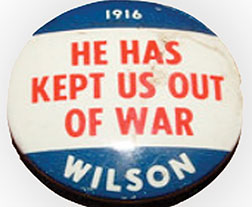 Button with Woodrow
Wilson’s 1916 presidential campaign slogan. Once reelected,
Wilson brought U.S. into imperialist First World War.
Button with Woodrow
Wilson’s 1916 presidential campaign slogan. Once reelected,
Wilson brought U.S. into imperialist First World War.George Bush Jr. – who claimed Saddam “tried to kill my dad” – presided over the new brutal U.S. invasion of Iraq in 2003 and the mass murder and colonial occupation that continued for years thereafter. This criminal enterprise wasn’t the work of just “one man”; he did it with more than a little help from his friends. Front and center were his VP Dick Cheney (frequently compared to Darth Vader, he is the father of present-day Republican Congresswoman Liz Cheney) and Secretary of State Colin Powell. After contributing to the attempted cover-up of the U.S. Army’s 1968 massacre of more than 500 unarmed civilians at My Lai, Powell ascended in the military brass. During the first Gulf War, he became head of the military high command, which, Army officials boasted, had large numbers of Iraqi troops deliberately buried alive by “combat earth movers” and tanks armed with plow blades (“U.S. Tank-Plows Said to Bury Thousands of Iraqis,” Los Angeles Times, 12 September 1991).
At CUNY, City College has a School for Civic and Global Leadership named after Colin Powell. In 2003, he was tasked with selling the official casus belli for Bush Jr.’s Iraq War. It was all about the “WMDs,” Powell proclaimed – “weapons of mass destruction” that Saddam Hussein’s government supposedly had, but didn’t. Appearing before the United Nations in February ’03, Powell presented supposedly “irrefutable” evidence – featuring a set of aerial photos – that supposedly proved the U.S. accusations.
It was a classic imperialist Big Lie to “shape and train the nation” for war. The capitalist media, both liberal and conservative, enlisted with gusto in selling it. (This is powerfully documented in the 2007 film War Made Easy: How Presidents and Pundits Keep Spinning Us to Death.) Against the repeated onslaughts of the U.S. (and its ally Britain) against Iraq, a semicolonial nation originally carved out by a secret WWI agreement between the UK and France (the Sykes-Picot Treaty of 1916), we revolutionary Marxists called to defeat U.S. imperialism and for the world’s workers to defend Iraq, without giving any political support to the bourgeois government of Saddam Hussein.
Bush Jr.’s Iraq War had its equivalent of the WWI campaign that told patriotic Americans to say “liberty cabbage” instead of “sauerkraut.” In March 2003, Congress ordered its cafeterias to change the name of French toast to “freedom toast” and French fries to “freedom fries.” The reason for this ludicrous exercise in culinary chauvinism? France was declining to enlist in the U.S./British “coalition of the willing” that launched the Iraq invasion.
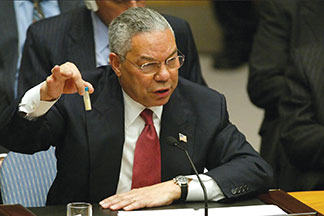 5 February 2003: Colin
Powell, then George W. Bush’s Secretary of State, delivers
lying “Weapons of Mass Destruction” speech to U.N. The war
propaganda blitz paved the way for U.S. imperialist
invasion, colonial occupation and mass murder in Iraq.
5 February 2003: Colin
Powell, then George W. Bush’s Secretary of State, delivers
lying “Weapons of Mass Destruction” speech to U.N. The war
propaganda blitz paved the way for U.S. imperialist
invasion, colonial occupation and mass murder in Iraq.(Photo: Timothy A. Clary / AFP)
As for the obscene lie that any of the U.S. imperialists’ wars have anything to do with saving children, mothers, or anyone or anything except their own profits and drive for world domination, the comments of Madeleine Albright, who died in March of this year, speak louder than a million pious claims. Former Secretary of State and U.S. Ambassador to the UN under Democratic president Bill Clinton, Albright was asked in a 60 Minutes interview about the 500,000 Iraqi children who died as a result of sanctions imposed on Iraq after the 1991 war. Her reply: “The price is worth it.”11 Years after the 1991 and 2003 invasions, the mass destruction that the U.S. inflicted on the people of Iraq has continued to fuel a crisis in maternal and child health, together with innumerable other consequences of the death and destruction wrought by the imperialist attack and occupation.12
“Your mission is to destroy as many Russian troops as you can,” George W. Bush told a phone prankster claiming to be Ukrainian president Volodymyr Zelensky in May, after noting that as president “I wanted Ukraine into NATO.” Indifferent in reality to the lives of Ukraine’s working people whom they have pushed as cannon fodder into the nationalist war, they pump out endless stories alleging one unspeakable atrocity after another by “the other side,” while their “responsible” media black out any and all evidence to the contrary, as well as the most basic facts about the historical background and present-day context of the conflict. Meanwhile the U.S. public hears nothing these days about the years-long, well-documented (including previously by mainstream media) terror, torture and killing carried out by Ukraine’s Azov Battalion and other fascist-infested forces, notably in the eight-year onslaught against Russian speakers in Donetsk and Luhansk, which caused 14,000 deaths.13
During the Spanish-American War school children were taught a martial ditty titled “Remember the Maine”; in WWI posters were plastered to “Remember Belgium”; in WWII it was “Remember Pearl Harbor” and in Vietnam a fabricated “Tonkin Gulf incident” was the casus belli for genocidal U.S. war... In the first Iraq war, people were instructed to “remember” Kuwaiti incubators and in the second to “remember” the “mad brute” Saddam’s non-existent WMDs. The U.S. rulers and their media mouthpieces told the populace to wear yellow ribbons to “support our troops.” Today, as Biden & Co. send mass shipments of weapons of death to fuel the Ukraine-Russia war, they say everything should be decked in blue and yellow Ukrainian flags. Today it is not the “Hun” that “must be destroyed,” according to the ceaseless deluge of war propaganda, but “mad brute” Russians led by the latest incarnation of “sheer evil,” Russian nationalist president Putin.
Having called for years, and continuing to call, to defend self-rule in the breakaway regions of southern and eastern Ukraine, on the eve of the war the League for the Fourth International issued a statement: “Defeat U.S./NATO War Drive and Sanctions Against Russia!” (23 February). As the conflict quickly became a general war between the Russian capitalist state and that of Ukraine (which has acted as a cat’s paw of Western imperialists), The Internationalist added: “We Trotskyists call for revolutionary defeatism on both sides in this reactionary nationalist war, for internationalist proletarian struggle against both capitalist regimes and, above all, against the U.S. and European rulers who set off this conflagration” (“Behind the War: U.S./NATO War Drive Against Russia, China,” 28 February).
Today, there is indeed much to be remembered from the long history of U.S. war propaganda and propaganda wars. This includes the reality that we must view with utmost suspicion – and understand the political purpose of – the claims and justifications put out by “our own” U.S. ruling class, which A-bombed Hiroshima and Nagasaki; unleashed napalm and carpet-bombing to kill millions in Korea and Vietnam; carried out countless murderous colonial invasions, occupations and proxy wars from the Caribbean to Central America to Africa to the Philippines and beyond, and twice invaded Iraq... Having set off, with its NATO partners, the current Russia-Ukraine conflagration, it is driving toward imperialist war against Russia and China and a thermonuclear World War III. At every step it has prepared and sought to cover its crimes with endless falsifications and deceptions.
“The truth is revolutionary” states a long-standing axiom of the Marxist movement. Opposing and exposing the weapons of mass deception and lies continually deployed by U.S. imperialism – this is part of our task as young revolutionaries determined to see capitalism’s masters of war defeated once and for all, by the workers of the world, not least those right here “at home.” ■
Beethoven Bans
and “Liberty Cabbage”
During World War I, the largest single ethnic group in the U.S. – German Americans – was targeted by the national-chauvinist crusade for “100 percent Americanism.” Many states and localities sought to ban people from speaking the German language in public, while one of the proliferating xenophobic groups, the American Defense Society, called to “make war on the Hun language” in a 1918 pamphlet titled Throw Out the German Language and All Disloyal Teachers.
Amidst the patriotic frenzy, sauerkraut was renamed “liberty cabbage” and frankfurters became “hot dogs.” While this absurd culinary jingoism might strike us as funny today, it was part of a campaign whose effects were widespread and sometimes violent. “Loyalty” groups like the American Protective League and Councils of National Defense joined in fanning a pogrom atmosphere, and people identified as German or “pro-German” were tarred and feathered in 13 states, sometimes resulting in fatalities, while others were forced to kiss the flag and promise to buy more Liberty bonds.
Imperialist war on battlefields overseas brought bellicose escalations on the domestic cultural front. In some U.S. cities, German-language theaters were forced to close. Beethoven was literally banned in one city after another, as his music, together with that of Bach, Schubert and others, was purged from music programs across the country. “German music [is] the most dangerous form of German propaganda,” the American Defense Society proclaimed, “because it appeals to the emotions and has power to sway an audience as nothing else can.” In Omaha, Nebraska, orchestra conductor Otto Scharf was targeted by a patriotic mob, which smeared yellow paint on the hotel where he was staying, and on the hotel’s owner. The cops arrested the conductor and charged him with disturbing the peace.
“In Pittsburgh, the city council issued a city-wide ban on all music by Beethoven. The Metropolitan Opera Company of New York forbade the production of German works; the Philadelphia Orchestra said it would stop performing all German music, beginning November 10, 1917. The superintendent of schools in New Jersey announced that German music would be banned throughout the state. In California, the state board of education ordered that textbook pages containing German songs be cut out.”14
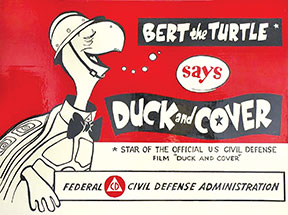 Propaganda poster for Cold War
U.S. government film featuring Bert the Turtle, a
character invented by the Federal Civil Defense
Administration in 1951 to teach children to “duck and
cover” under their school desks as part of “preparedness”
campaign for nuclear war against USSR.
Propaganda poster for Cold War
U.S. government film featuring Bert the Turtle, a
character invented by the Federal Civil Defense
Administration in 1951 to teach children to “duck and
cover” under their school desks as part of “preparedness”
campaign for nuclear war against USSR.Readers today might imagine that those are just pages from a distant past. But take a look at what’s going on in the year 2022. “Venues across the West are shunning Russian musicians, ballet dancers and films,” announced CBS News (21 April), amidst the reactionary nationalist war provoked by the U.S. and NATO (North Atlantic Treaty Organization). In early March, New York’s Metropolitan Opera banned Russian superstar soprano Anna Netrebko. The banning of Netrebko (who was replaced by a Ukrainian singer) likely presaged the end of the Met’s collaboration with Moscow’s Bolshoi Theater. Meanwhile Carnegie Hall hastened to cancel all performances by the Mariinsky Orchestra with world-famous conductor Valery Gergiev and pianist Denis Matsuev. If things like this make you crave some vodka and you head for a nearby liquor store, you’re likely to be told: “All Russian products have been taken off the shelves.” ■
- 1. Stewart Halsey Ross, Propaganda for War: How the United States Was Conditioned to Fight the Great War of 1914-1918 (2009)
- 2. The song “Masters of War” (Bob Dylan, 1962) came out shortly after JFK threatened to blow up the world in the Cuban Missile Crisis. You can listen to it online at youtube.com/watch?v=JEmI_FT4YHU
- 3. Erik Van Schaack, “The Division of Pictorial Publicity in World War I,” Design Issues, Winter 2006.
- 4. A widely-read exposé of Belgium’s colonial crimes was Mark Twain’s 1906 pamphlet King Leopold’s Soliloquy (1906). See “Mark Twain and the Onset of the Imperialist Epoch” and “U.S. Was Godfather of Colonial Enslavement of the Congo,” The Internationalist No. 3, September-October 1997, as well as “‘Human Rights Imperialism’ and the Congo Holocaust,” The Internationalist No. 9, January-February 2001.
- 5. See “Espionage Act of 1917,” online First Amendment Encyclopedia (August 2022) and “Free Julian Assange – No Extradition, U.S. Hands Off Edward Snowden,” The Internationalist No. 62, January-March 2021.
- 6. The judge’s decision is online at casetext.com/case/united-states-v-motion-picture-film-the-spirit-of.
- 7. Alan Axelrod, Selling the Great War: The Making of American Propaganda (2009). Axelrod states that Creel and his committee became “very familiar to such earnest students of propaganda as Adolf Hitler and Joseph Goebbels, both of whom looked to the American government’s World War I ‘information’ program as a model on which to build [Germany’s] propaganda industry.” On CPI techniques’ long-term impact, also see John Maxwell Hamilton, Manipulating the Masses: Woodrow Wilson and the Birth of American Propaganda (2020) and Susan A. Brewer, Why America Fights: Patriotism and War Propaganda from the Philippines to Iraq (2009).
- 8. See “The Lies Behind Imperialist Crimes: From Pentagon Papers to Afghanistan Papers,” Revolution No. 17, August 2020, and “Afghanistan: Humiliating Defeat for Murderous U.S. Imperialism,” The Internationalist No. 64, July-September 2021.
- 9. Eugene Secunda and Terence P. Moran, Selling War to America: From the Spanish American War to the Global War on Terror (2007).
- 10. “When contemplating war, beware of babies in incubators,” Christian Science Monitor, 6 September 2002.
- 11. See “Madeleine Albright: Death of a Cold War Criminal,” The Internationalist No. 66, January-April 2022.
- 12. “Roots of Iraq’s maternal and child health crisis run deep,” The Lancet, 16 March 2013.
- 13. See “The Truth About Ukraine’s Fascist Infestation,” The Internationalist No. 66, January-April 2022.
- 14. Erik Kirschbaum, Burning Beethoven: The Eradication of German Culture in the United States in World War I (2015).
